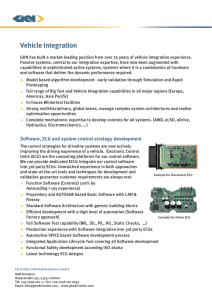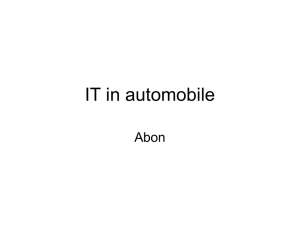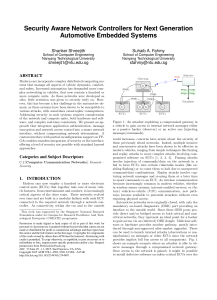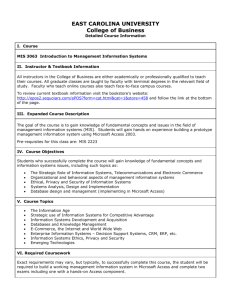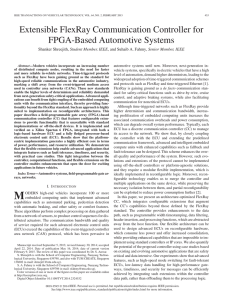Zero Latency Encryption with FPGAs for Secure Time-Triggered Automotive Networks Shanker Shreejith
advertisement
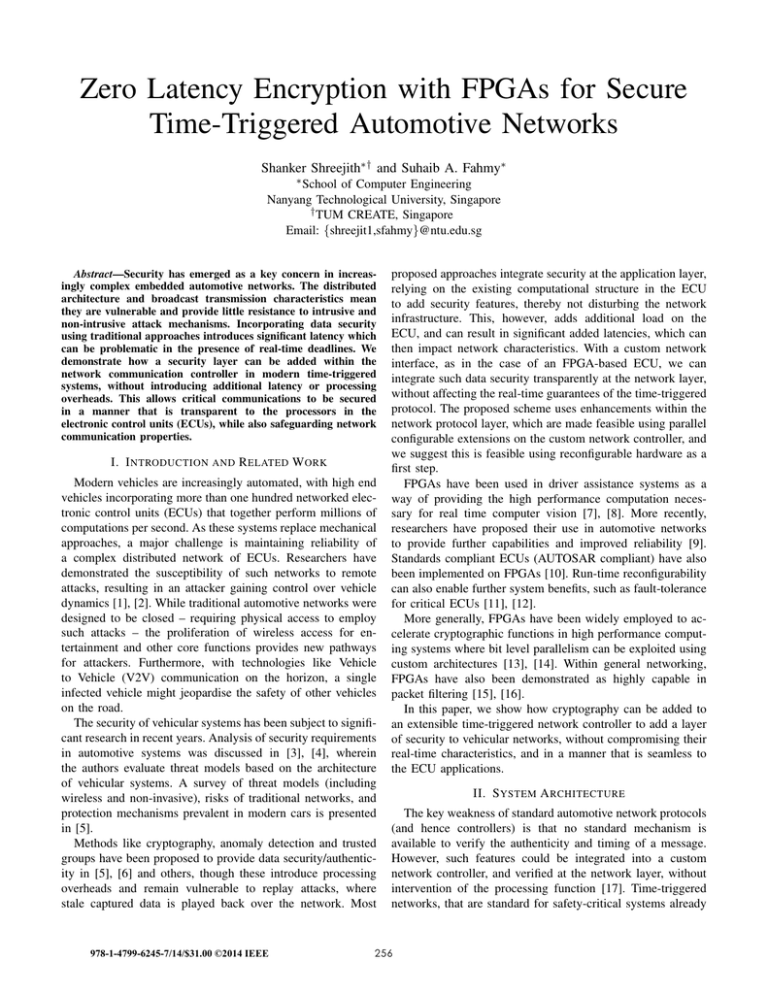
Zero Latency Encryption with FPGAs for Secure
Time-Triggered Automotive Networks
Shanker Shreejith⇤† and Suhaib A. Fahmy⇤
⇤ School
of Computer Engineering
Nanyang Technological University, Singapore
† TUM CREATE, Singapore
Email: {shreejit1,sfahmy}@ntu.edu.sg
Abstract—Security has emerged as a key concern in increasingly complex embedded automotive networks. The distributed
architecture and broadcast transmission characteristics mean
they are vulnerable and provide little resistance to intrusive and
non-intrusive attack mechanisms. Incorporating data security
using traditional approaches introduces significant latency which
can be problematic in the presence of real-time deadlines. We
demonstrate how a security layer can be added within the
network communication controller in modern time-triggered
systems, without introducing additional latency or processing
overheads. This allows critical communications to be secured
in a manner that is transparent to the processors in the
electronic control units (ECUs), while also safeguarding network
communication properties.
I. I NTRODUCTION AND R ELATED W ORK
Modern vehicles are increasingly automated, with high end
vehicles incorporating more than one hundred networked electronic control units (ECUs) that together perform millions of
computations per second. As these systems replace mechanical
approaches, a major challenge is maintaining reliability of
a complex distributed network of ECUs. Researchers have
demonstrated the susceptibility of such networks to remote
attacks, resulting in an attacker gaining control over vehicle
dynamics [1], [2]. While traditional automotive networks were
designed to be closed – requiring physical access to employ
such attacks – the proliferation of wireless access for entertainment and other core functions provides new pathways
for attackers. Furthermore, with technologies like Vehicle
to Vehicle (V2V) communication on the horizon, a single
infected vehicle might jeopardise the safety of other vehicles
on the road.
The security of vehicular systems has been subject to significant research in recent years. Analysis of security requirements
in automotive systems was discussed in [3], [4], wherein
the authors evaluate threat models based on the architecture
of vehicular systems. A survey of threat models (including
wireless and non-invasive), risks of traditional networks, and
protection mechanisms prevalent in modern cars is presented
in [5].
Methods like cryptography, anomaly detection and trusted
groups have been proposed to provide data security/authenticity in [5], [6] and others, though these introduce processing
overheads and remain vulnerable to replay attacks, where
stale captured data is played back over the network. Most
978-1-4799-6245-7/14/$31.00 ©2014 IEEE
proposed approaches integrate security at the application layer,
relying on the existing computational structure in the ECU
to add security features, thereby not disturbing the network
infrastructure. This, however, adds additional load on the
ECU, and can result in significant added latencies, which can
then impact network characteristics. With a custom network
interface, as in the case of an FPGA-based ECU, we can
integrate such data security transparently at the network layer,
without affecting the real-time guarantees of the time-triggered
protocol. The proposed scheme uses enhancements within the
network protocol layer, which are made feasible using parallel
configurable extensions on the custom network controller, and
we suggest this is feasible using reconfigurable hardware as a
first step.
FPGAs have been used in driver assistance systems as a
way of providing the high performance computation necessary for real time computer vision [7], [8]. More recently,
researchers have proposed their use in automotive networks
to provide further capabilities and improved reliability [9].
Standards compliant ECUs (AUTOSAR compliant) have also
been implemented on FPGAs [10]. Run-time reconfigurability
can also enable further system benefits, such as fault-tolerance
for critical ECUs [11], [12].
More generally, FPGAs have been widely employed to accelerate cryptographic functions in high performance computing systems where bit level parallelism can be exploited using
custom architectures [13], [14]. Within general networking,
FPGAs have also been demonstrated as highly capable in
packet filtering [15], [16].
In this paper, we show how cryptography can be added to
an extensible time-triggered network controller to add a layer
of security to vehicular networks, without compromising their
real-time characteristics, and in a manner that is seamless to
the ECU applications.
II. S YSTEM A RCHITECTURE
The key weakness of standard automotive network protocols
(and hence controllers) is that no standard mechanism is
available to verify the authenticity and timing of a message.
However, such features could be integrated into a custom
network controller, and verified at the network layer, without
intervention of the processing function [17]. Time-triggered
networks, that are standard for safety-critical systems already
ECU Interface
2
Protocol Management
Data Layer
Crypto
Access Control
2
Timestamp
Clock Sync.
Coding/Decoding
2
1
Bit Tx/Rx
FlexRay Bus
Fig. 1: Time-triggered network enhanced with an intermediate
timestamp and data-ciphers.
offer a synchronised view of time at different nodes in the network, and this can be leveraged for securing communication. If
messages can be augmented with a timestamp, that identifies
when the message was sent, this could allow stale data to
be rejected. Adding encryption of messages would allow an
ECU to be certain of the source of the message. Our approach
enhances the communication controller (CC) by integrating
a data cipher into the architecture, as shown in Fig. 1, thus
altering the normal datapath (marked 1), creating the enhanced
datapath (marked 2). Reformatting a data stream to include
a timestamp introduces additional entropy to otherwise static
data, as proposed in [18] for TCP frames. These extensions
are overlapped with standard functions within the CC by
extending the datapath using double buffering, prefetching,
pipelining, and high wordlength interconnect. Though such
extensions could be implemented in software running on the
ECU processor, this would result in significant overheads in
computation and synchronisation, as well as large variations
between the actual time of transmission and the timestamp
encoded in the messages.
We present a study using FlexRay, a state-of-the-art timetriggered protocol, to show how the security enhancements can
be deterministically integrated into automotive networks. A
low-latency PRESENT cipher [19] that can meet the real-time
and power/computational constraints imposed by automotive
ECUs, is used for the evaluation. Though our experiment uses
PRESENT over a FlexRay network, the same principles can
be used with other low-latency ciphers and/or time-triggered
networks.
A. Secure FlexRay Communication Controller
The FlexRay communication controller (CC) is an implementation of the protocol specification defined by the
FlexRay consortium [20]. It allows an ECU to integrate onto
the FlexRay bus to exchange messages with other ECUs.
The implementation can be a standalone integrated circuit,
integrated with micro-controllers as a module, or built using
logic in an FPGA.
The FlexRay CC comprises of two functional modules: the
Protocol Engine (PE) implements the complete protocol, as
defined by the standard, while the Controller Host Interface
(CHI) implements a generic interface to the ECU function.
The protocol is implemented using the functional sub-blocks,
encapsulated within the PE: Clock Synchronisation (CS)
that manges synchronisation and timing, Medium Interface
Layer (MIL) that handles encapsulation/decapsulation and
encoding/decoding of data, and Protocol Management Module
(PMM) that controls the PE based on network conditions and
ECU commands.
Fig. 2 shows the datapath extensions that implement timestamping and timestamp synchronisation at the interface, integrated into the MIL module of our secure CC. These
extensions are possible as we have designed our CC to support
extensions in the datapath at the network level [21]. The
normal dataflow path in a standard controller design is marked
as NP in Fig. 2, where the data from the processing logic flows
up/down from/to the bitwise decoding/encoding blocks. With
our integrated timestamp block, the communication controller
establishes a common time-base using techniques defined
by the FlexRay protocol during the initialisation phase of
the network. A leading coldstart node initialises the start-up
procedure where it transmits a start-up frame and waits for
other coldstart nodes to join in. Once more than two coldstart
nodes integrate, non-coldstart nodes (i.e., the ones which
cannot trigger the start-up procedure) adopt this schedule and
integrate into the network completing the start-up procedure.
We have integrated the timestamp start-up procedure to closely
follow the FlexRay clock synchronisation scheme, thus providing a common time-base to all participating nodes, with
provisions to correct for drifts.
On the transmit path, the timestamp insertion logic appends
timestamp information into the outgoing data, just before it
is encoded into the byte-packed format for transmission, all
within the CC. Alternatively, if the function is disabled, the
ECU processor would instead read the timestamp information
and append it to the sensor data before passing it on to the CC
for transmission. Similarly, on the receive path, the timestamp
processing unit extracts the timestamp information from the
decoded data and can be configured to reject incoming data if
the timestamp is not current. Alternatively, it can forward the
entire packet to the ECU (as in the normal case), where the
ECU would compare its timestamp to the current time (from
the CC) and decide on its validity.
The timestamped data is encrypted by the cryptographic
block using a pre-shared key, then encoded and transmitted
bit-by-bit, as per the FlexRay standard. In the receive path,
the bits from the physical medium are voted and decoded as
per the FlexRay protocol. The cryptographic block deciphers
the received data and extracts the timestamp, which is then
validated, with the plain text data forwarded upstream. This
cipher enhanced datapath is shown in Fig. 2 marked as PP.
The PRESENT module uses multiple iterations (or rounds)
of substitution and permutation operations to convert an incoming data block into cipher text, each round is controlled
Transit
Memory
NP
ECU Data
+
PP
Schedule Info
Clock Sync Info
Timestamp
FlexRay Bus
Byte Encoder
PP
PRESENT
Timestamp
Timestamp
Timer
PP
PRESENT
Encoder
Bitwise Txr
Timestamp
Control
FlexRay
Clock Sync
Control
SM
Upper Layers
Bit Voting
Byte Decoder
Timestamp
Validation
Timestamp
PP
PRESENT
Decoder
Decrypted Data
Valid Data
PP
Transit
Memory
NP
Decoded Data
Fig. 2: Datapath extensions: timestamp synchronisation, processing and cipher logic
by a round key. The cipher operates on a block of 64 bits and
can be configured to have 80 or 128 bit keys and can have up
to 65536 rounds per cycle. These options can be changed by
the ECU during operation.
The PRESENT module instantiates one buffer each in the
transmit and receive direction to store the (prefetched) data
from/to the upper layers. 64-bit datapaths are used to ensure
that a block is transferred in every single cycle. Once a
block of data is available in the buffer, it is read out in
one cycle and further encrypted in n cycles, where n is a
configurable number of rounds. A key store manages the round
keys for each round, and handles the commands to alter cipher
properties (no. of rounds, keys) by regenerating the new set of
keys in the background using a double buffer. The pipelined
operation enables the encryption/decryption to overlap with
transmission/reception of previous/subsequent data blocks (or
headers), effectively hiding the latency in the buffering latency
that is present even with no encryption.
TABLE I: Comparison of CC resources on XC6VLX240T.
Function
Submodule
FFs
LUTs
BRAMs
DSPs
normal CC
MIL ⇥ 2
Others
1038
3541
1610
5881
2
12
0
2
Total
5617
9068
16
2
PRESENT ⇥ 2
MIL ⇥ 2
Others
2548
1275
3578
2274
1463
6081
4
3
12
0
0
2
Total
11224
13386
26
2
5607
99.8%
4318
47.62%
10
62.5%
0
0%
secure CC
Overhead
(%)
ECU1
Switches
t0
msg1
t1
ECU2
t2
Secure
FlexRay
msg2
B. Software Encryption
When a powerful computational core (or co-processor) is
available in the ECU, data encryption can be carried out within
the ECU instead. In such a case, the current time value is read
from the CC registers and is used to encode the data by using
round-keys generated in the same manner. In the receive path,
the decoded timestamp value from the header segment is read
into the ECU to decode the data. However, we observe that
the timestamps are inaccurate as there is no synchronisation
between the communication schedule and tasks schedule on
the ECU.
III. T EST S ETUP AND R ESULTS
To evaluate the proposed scheme, we have integrated four
ECUs on a single Xilinx Virtex-6 LX240T FPGA (Xilinx ML605 development board), connected together using a FlexRay
bus channel which is completely contained within the FPGA,
replicating an emulated cluster of ECUs [22]. Each ECU in
Fig. 3 is served by a local clock and comprises a MicroBlaze
LEDs
t5
t4
ECU3
msg3
t3
ECU4
Fig. 3: Test setup with 4 ECUs on ML-605 development board.
softcore processor (each slightly differing in memory configuration) integrated to our secure FlexRay CC. These run a
set of tasks that generate incremental data patterns every 100
milliseconds and exchange data in every cycle of duration
10 milliseconds. The enhanced CC consumes up to 86% of
resources in each ECU, with the test setup consuming 44%
of the Virtex-6 device, and can be clocked up to 124 MHz,
more than the 80 MHz required by FlexRay. Table I describes
the utilisation of the secure CC in more detail, comparing it
against a standard implementation without enhancements. It
can be observed that including the PRESENT logic within
the controller results in higher resource consumption and
marginally higher power consumption than the standard core.
TABLE II: Latency of operation per 64 bit data block
Impli. (Rounds, Clock)
HW (up to 470, 80 MHz)
SW MB (32, 100 MHz)
SW ARM (32, 667 MHz)
Encryption(µs)
Decryption(µs)
w/in Txn boundary
7204
40.9
w/in Rxn boundary
7450
42.1
We also evaluate the cost of performing encryption in
software as opposed to the integrated approach within the
CC. For this, a C implementation of PRESENT is used
on the MicroBlaze ECUs. We also evaluated the same on
an ARM-based ECU using a Xilinx Zynq platform. The
results are shown in Table II. We observe that the integrated
approach (in CC) does not incur any additional latency in
the transmit or receive direction for handling sensor data
encryption, since encryption/decryption are performed during
buffering. Meanwhile the software versions require 41 µs and
7 ms on the ARM and MicroBlaze respectively for every 64
bits of data to be encoded or decoded. This delay could be
reduced by offloading encryption to a dedicated co-processor
like custom IP on the MicroBlaze or the Neon engine on
the Zynq. Furthermore, the software implementations rely on
additional data exchange (timestamp) between the ECU and
CC which results in some inaccuracy, with a worst case slack
of a complete network cycle.
IV. C ONCLUSION
Concerns about the security of automotive networks, and
demonstrations of serious compromises in modern vehicles
are focusing attention on the security of such systems. We
have presented an approach to integrating data security in
automotive networks that leverages information available at the
lower layers of a time-triggered protocol. An ultra lightweight
cryptographic function and synchronised timestamps incorporated within the network layer of a custom CC mean
we can add security without affecting the real-time nature
of such messages. The approach is portable to other timetriggered networks that may replace FlexRay as the backbone
for automotive systems. The computational capability and
configurable nature of FPGAs enable such configurable levels
of security to be integrated into the protocol layers with no
loss in determinism, which is impossible to achieve using offthe-shelf components.
We aim to investigate extending the security architecture
by incorporating mechanisms to securely generate unique
identifiers for each ECU, and exploring partial reconfiguration
for altering cipher schemes in response to threats. We are also
working on a key-management mechanism that can generate,
exchange and revoke keys and policies which can adapt to
different threat scenarios, thus providing true dynamic security.
ACKNOWLEDGMENT
This work was supported by the Singapore National Research Foundation under its Campus for Research Excellence
And Technological Enterprise (CREATE) programme.
R EFERENCES
[1] K. Koscher, A. Czeskis, F. Roesner, S. Patel, T. Kohno, S. Checkoway,
D. McCoy, B. Kantor, D. Anderson, H. Shacham, and S. Savage,
“Experimental Security Analysis of a Modern Automobile,” in IEEE
Symp. on Security and Privacy (SP), May 2010, pp. 447–462.
[2] S. Checkoway, D. McCoy, B. Kantor, D. Anderson, H. Shacham,
S. Savage, K. Koscher, A. Czeskis, F. Roesner, T. Kohno et al., “Comprehensive Experimental Analyses of Automotive Attack Surfaces,” in
USENIX Security Symposium, 2011.
[3] O. Henniger, L. Apvrille, A. Fuchs, Y. Roudier, A. Ruddle, and B. Weyl,
“Security requirements for automotive on-board networks,” in Proc. Int.
Conf. on Intelligent Transport System Telecommunications (ITST), 2009.
[4] D. K. Nilsson, P. H. Phung, and U. E. Larson, “Vehicle ECU classification based on safety-security characteristics,” in Proc. Conf. on Road
Transport Information and Control, 2008.
[5] I. Studnia, V. Nicomette, E. Alata, Y. Deswarte, M. Kaaniche, and
Y. Laarouchi, “Survey on security threats and protection mechanisms in
embedded automotive networks,” in Proc. Conf. on Dependable Systems
and Networks Workshop (DSN-W), 2013.
[6] A. Groll and C. Ruland, “Secure and authentic communication on
existing in-vehicle networks,” in IEEE Intelligent Vehicles Symp., 2009.
[7] N. Alt, C. Claus, and W. Stechele, “Hardware/software architecture
of an algorithm for vision-based real-time vehicle detection in dark
environments,” in Proc. Design, Automation and Test in Europe (DATE)
Conference, 2008.
[8] C. Claus, R. Ahmed, F. Altenried, and W. Stechele, “Towards rapid dynamic partial reconfiguration in video-based driver assistance systems,”
in Proc. Int. Symp. on Applied Reconfigurable Computing (ARC), 2010.
[9] S. Shreejith, S. Fahmy, and M. Lukasiewycz, “Reconfigurable Computing in Next-Generation Automotive Networks,” IEEE Embedded Systems
Letters, vol. 5, no. 1, p. 12 to 15, 2013.
[10] F. Fons and M. Fons, “FPGA-based Automotive ECU Design Addresses
AUTOSAR and ISO 26262 Standards,” Xcell journal, vol. Issue 78, pp.
20–31, 2012.
[11] N. Chujo, “Fail-safe ECU System Using Dynamic Reconfiguration of
FPGA,” R & D Review of Toyota CRDL, vol. 37, pp. 54–60, 2002.
[12] S. Shreejith, K. Vipin, S. A. Fahmy, and M. Lukasiewycz, “An Approach
for Redundancy in FlexRay Networks Using FPGA Partial Reconfiguration,” in Proc. Design, Automation and Test in Europe (DATE)
Conference, 2013, pp. 721–724.
[13] N. Bourbakis and A. Dollas, “SCAN-based compression-encryptionhiding for video on demand,” IEEE MultiMedia, vol. 10, no. 3, pp.
79–87, 2003.
[14] J. Fernando, D. Dalessandro, A. Devulapalli, and K. Wohlever, “Accelerated FPGA based encryption,” in The 2005 Cray Users Group
Conference, 2005.
[15] B. L. Hutchings, R. Franklin, and D. Carver, “Assisting network intrusion detection with reconfigurable hardware,” in Proc. IEEE Symposium
on Field-Programmable Custom Computing Machines (FCCM), 2002,
pp. 111–120.
[16] I. Sourdis and D. Pnevmatikatos, “Fast, large-scale string match for a
10 Gbps FPGA-based network intrusion detection system,” in Proc. Int.
Conf. on Field Programmable Logic and Application (FPL), 2003, pp.
880–889.
[17] S. Shreejith and S. Fahmy, “Extensible FlexRay Communication Controller for FPGA-Based Automotive Systems,” IEEE Transactions on
Vehicular Technology, vol. To Appear, 2015.
[18] J. Giffin, R. Greenstadt, P. Litwack, and R. Tibbetts, “Covert messaging
through TCP timestamps,” in Proc. Int. Workshop on Privacy Enhancing
Technologies, 2003.
[19] A. Bogdanov, L. R. Knudsen, G. Leander, C. Paar, A. Poschmann,
M. J. B. Robshaw, Y. Seurin, and C. Vikkelsoe, “PRESENT: An
ultra-lightweight block cipher,” in Proc. Workshop on Cryptographic
Hardware and Embedded Systems (CHES), 2007.
[20] FlexRay Communications System, Protocol Specification Version 2.1
Revision A, FlexRay Consortium Std., December 2005.
[21] S. Shreejith and S. A. Fahmy, “Enhancing communication on automotive
networks using data layer extensions,” in Proc. Int. Conf. on Field
Programmable Technology (FPT), 2013, pp. 470–473.
[22] S. Shreejith, S. A. Fahmy, and M. Lukasiewycz, “Accelerating Validation
of Time-Triggered Automotive Systems on FPGAs,” in Proc. Int. Conf.
on Field Programmable Technology (FPT), 2013, pp. 4–11.


